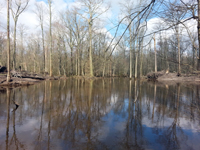Recent News
Pocomoke River Restoration Project: Enhancing resiliency to climate variability and flooding

The Pocomoke River Restoration project is a partnership between the Natural Resources Conservation Service (NRCS), U.S. Fish and Wildlife Service (FWS), Maryland Department of Natural Resources (DNR), U.S. Geological Survey (USGS), and The Nature Conservancy (TNC). Read more...

Visit the Trust Fund Tracker to learn about restoration projects funded through the
Trust Fund.

Visit our Flickr page to view restoration project photos.
Contact Information
Chesapeake & Coastal Service
Maryland Department of Natural Resources
Tawes State Office Building, E2
580 Taylor Avenue
Annapolis, Maryland 21401
Phone 410-260-8732
Fax 410-260-8739
[email protected]